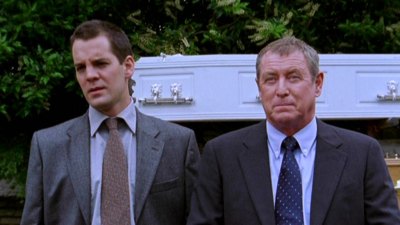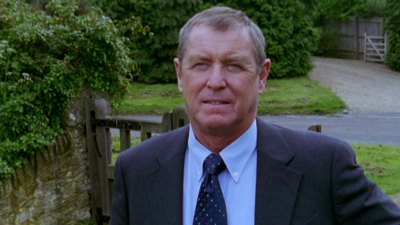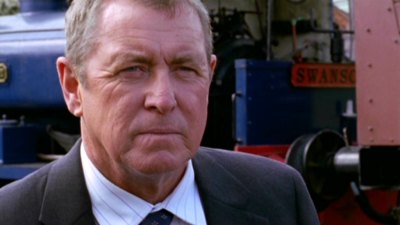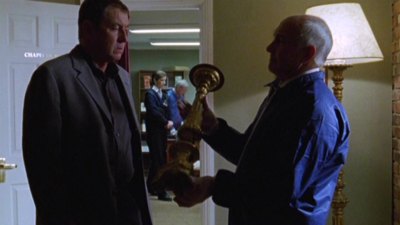| Reviews & Columns |
|
Reviews DVD TV on DVD Blu-ray 4K UHD International DVDs In Theaters Reviews by Studio Video Games Features Collector Series DVDs Easter Egg Database Interviews DVD Talk Radio Feature Articles Columns Anime Talk DVD Savant Horror DVDs The M.O.D. Squad Art House HD Talk Silent DVD
|
DVD Talk Forum |
|
|
| Resources |
|
DVD Price Search Customer Service #'s RCE Info Links |
|
Columns
|
|
|
Midsomer Murders - Set Nine

Now I've written before about Midsomer Murders (please click here to read that review), and since watching that particular set, I've gone back and viewed some earlier shows, as well. And I have to say that I don't think the series has flagged in the slightest during this eighth series. The episodes included in Midsomer Murders: Set Nine - Things That Go Bump In the Night, Dead in the Water, Orchis Fatalis, and Bantling Boy - all possess the series' strange, funny mix of eccentric, deceptively "quaint" English characters, a delicious sense of reveling in the macabre, and a distinctly English standoffishness in the face of utter mayhem. So much of Midsomer Murders is a smart put-on of the classic "English village" mystery genre, and so competently done, that it can be enjoyed as either straight representation of that form, or as a low-key farcical commentary on it.
It's been noted before of the ridiculously high murder count in the fictional Midsomer County (much like the fictional Cabot Cove - or any other place that Murder, She Wrote's Jessica Fletcher happens to find herself), and if you watch the series end to end, I suppose that sense of the absurd would be driven home more forcefully. After all, a series of seemingly unending gruesome murders in small, affluent rural villages, all in the same county, week after week? But since each episode is largely self-contained (a bonus for newcomers to the series, like myself earlier this year), and the murders occur in various small villages throughout the County, you can approach each entry as a "straight" mystery. Taking all the episodes together, however, the silliness of the crime rate becomes quite funny.
And John Nettles' square, stolid interpretation of Detective Barnaby further reinforces that initial feeling that we're watching a deceptively uncomplicated piece of genre work. Designed specifically to have no distinguishing quirks or "handles" to attract the audience (no Columbo raincoat and junker car; no Rockford Files trailer parked in an empty lot), the Barnaby character at first glance appears colorless, but Nettles' assured, minimal performance is perfectly pitched for the understated British diffidence and sly wit that marks each Midsomer Murders. And after watching him closely, you can see Nettles putting his own restricted little spins on his line readings and his closed-off facial expressions, bringing just the right amount of commentary on the patently outlandish goings-on in Midsomer County.

Much of the humor of Midsomer Murders comes not from the lead characters (Detective Barnaby's sidekick, Detective Sergeant Dan Scott - well played by John Hopkins - gets quite a few laughs with his frequent incredulity at the goings-on in the various villages), but from the bizarre, peculiar inhabitants and suspects that lurk in the corners of the deadly County. In Midsomer Murders: Set Nine, we have everything from phony mediums, to randy rowers, to libidinous orchid enthusiasts, to a monk who gladly translates a sex-filled diary written in Latin. The series presents these potentially broad characters in the most low-key manner, letting the audience get the jokes if they care to.
One of the series' strong points is its ability to take a seemingly innocuous, mundane affair - such as a flower show in Orchis Fatalis -- and gradually peel away the lackluster layers of the social façade to reveal the perverse, seamy underbelly of greed, lust, and ambition that drive the truly terrible crimes that are visited upon the countyfolk - while providing plenty of smart comedy along the way. These facades - the breakdown of traditional churchgoing in favor of trendy spiritualism in Things That Go Bump in the Night; the posh gilt of the aristocratic regatta in Dead in the Water; the seemingly genteel hobby of orchid growing in Orchis Fatalis; and horse - and family - breeding in Bantling Boy - are frequently tied in with plot elements that emphasize nostalgia and a sense of a disappearing way of English life. This isolation, both in actual locale and in thematic elements stuck in events obsessed with passing traditions, further removes Midsomer Murders from reality, creating a series of cozy mysteries starring broad, unusual characters - with surprisingly tart resonance.
Of the four episodes of Midsomer Murders: Set Nine included in this set, the first episode, Things That Go Bump in the Night is particularly strong, creating an almost The Wicker Man feel to its story of spiritualism engulfing a small village in fear. Certainly the recreation of the murder at the episode's finale, with the murderer naked and chortling after killing the victim, is one of the more disturbing, perverse moments in the series (and again, funny at the same, awful time). Dead in the Water is a more straightforward episode (brightly photographed, with plenty of subtle comedy between Barnaby and Scott), while Orchis Fatalis is quite brilliant at peeling away its layer upon layer of licentiousness as we try to understand what would make orchid growers kill each other (here's a hint: money). And Bantling Boy is clever in jumping back and forth between red-herring suspects, while we ponder the nature of breeding in the aristocracy. Certainly one of the funniest lines in the series comes at the end of this episode; Barnaby, discussing violent video games, states with a straight face, "When killing becomes entertainment, we all lose touch with reality." Of course, this is deliberately hilarious (and ironic), considering the weekly massacres that occur in Midsomer County. And delightfully entertaining massacres they are, as well.

DISC ONE:
Things That Go Bump in the Night
The murder of undertaker Patrick Pennyman brings Barnaby and Scott to Fletcher's Cross, where villagers are divided in their feelings about a local spiritualist church. As the body count rises, the detectives begin to suspect a link between the funeral parlor, the Spirit of Friendship Group, and a new friend of Joyce Barnaby's.
DISC TWO:
Dead in the Water
A peaceful Barnaby family outing to watch the Midsomer Regatta ends with the discovery of the body of Rowing Club chairman Guy Sweetman. A notorious philanderer, Guy upset many people in his life, including fellow rowers, jealous husbands, and jilted conquests. But who was angry enough to kill him?
DISC THREE:
Orchis Fatalis
When one of the world's rarest orchids turns up in Midsomer Malham, passion, compulsion, and jealousy lead to murder. Barnaby and Scott must find the Yellow Roth and determine who would stop at nothing to own the priceless specimen.
DISC FOUR:
Bantling Boy
The owner of Bantling Hall dies and leaves his prize racehorse to a syndicate of four people, one of whom is his son, a horse trainer. But the windfall turns out to be extremely unlucky for all of them. Barnaby and Scott enter the world of horseracing and discover a shocking secret worth killing for.

The DVD:
The Video:
The 16:9 anamorphic widescreen video image for Midsomer Murders: Set Nine is immaculately sharp and clear, with full colors and blacks that hold in the numerous night scenes. Again, as with the previous set, I was impressed with the show's glossy lensing, and it looks particularly good here in this DVD transfer.
The Audio:
The Dolby Digital English 2.0 stereo soundtrack is effective and strong. There are no subtitles or close-captioning options, but the English accents are very mild here, so no worries.
The Extras:
There's a text bio on author Caroline Graham, as well as text filmographies for the cast.
Final Thoughts:
From the first strains of that deliciously creepy little theme (which would have been worthy of Hitchcock), the Midsomer Murders: Set Nine mysteries take you to a fictional county of reserved English villages, quaint traditions, and uncontrolled mass murder. Observing it all is the wry, flint-eyed Detective Chief Inspector Barnaby, who stoically plows through the various crime scenes, fully aware that more murders will inevitably occur. If you're new to Midsomer Murders, don't feel you can't jump right into the mayhem. These are delightfully droll little mysteries that will keep you guessing - and laughing - right up to their surprising revelations. I highly recommend Midsomer Murders: Set Nine.
Paul Mavis is an internationally published film and television historian, a member of the Online Film Critics Society, and the author of The Espionage Filmography.


|
| Popular Reviews |
| Sponsored Links |
|
|
| Sponsored Links |
|
|
| Release List | Reviews | Shop | Newsletter | Forum | DVD Giveaways | Blu-Ray | Advertise |
|
Copyright 2024 DVDTalk.com All Rights Reserved. Legal Info, Privacy Policy, Terms of Use,
Manage Preferences,
Your Privacy Choices | |||||||













